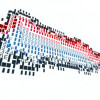Quantum computer research reaches ‘significant milestone’
Scientists at Santa Barbara University have announced major advancements in the development of a large scale quantum computer, as well as a breakthrough in the quantum control of light.
The team, which included scientists from Zhejiang University in China and NEC, Japan, used a superconducting quantum integrated circuit to generate unique quantum states of light known as NOON states. These states, generated from microwave frequency photons (the quantum unit of light), were created and stored in two physically separated microwave storage cavities.
According to Haohua Wang, postdoctoral fellow in physics at Santa Barbara University, the quantum NOON states were created using one, two, or three photons. All of these photons were placed in one cavity, leaving the other empty. This was simultaneous with the first cavity being empty, with all the photons stored in the second cavity. "This seemingly impossible situation, allowed by quantum mechanics, led to interesting results when we looked inside the cavities," he said. "There was a 50% chance of seeing all the photons in one cavity and a 50% chance of not finding any – in which case all the photons could always be found in the other cavity."









































































